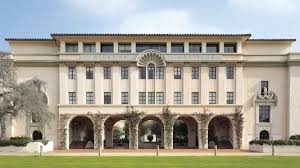Nestled amidst the vibrant sprawl of Los Angeles lies the California Institute of Technology (Caltech), a beacon of scientific exploration and technological innovation. Founded in 1891, Caltech has risen from humble beginnings to become a global powerhouse in science and engineering, consistently ranking among the top universities in the world. This article delves into the unique character of Caltech, exploring its focus on fundamental research, its collaborative spirit, and its unwavering commitment to pushing the boundaries of human knowledge.
A Seed of Curiosity Takes Root
Caltech’s story begins with a vision rooted in curiosity. Amos G. Throop, a businessman and politician, envisioned an institution dedicated to fostering a love for learning and the pursuit of scientific inquiry. This spirit of intellectual curiosity continues to be the lifeblood of Caltech, attracting students and faculty who are passionate about delving into the fundamental mysteries of the universe.
Early on, Caltech embraced a unique approach to education. Unlike traditional universities with sprawling departments, Caltech operates on a smaller scale, fostering a close-knit community of scholars. This allows for intensive collaboration between faculty and students, creating an environment where groundbreaking research thrives. The undergraduate experience at Caltech is rigorous, emphasizing a deep understanding of fundamental scientific principles, preparing graduates for success in research and beyond.
A Hub of Collaborative Genius
Caltech’s collaborative spirit is one of its defining characteristics. Faculty across disciplines work together on complex problems, breaking down silos and fostering a cross-pollination of ideas. The Kavli Nanoscience Center, for example, brings together physicists, chemists, engineers, and biologists to explore the world on the atomic and molecular scale. This collaborative approach allows researchers to tackle challenges from diverse perspectives, leading to groundbreaking discoveries.
Beyond faculty collaboration, Caltech fosters a strong sense of community among students. Small class sizes and a residential campus environment create a space where students can learn from each other, share ideas, and engage in stimulating discussions. Undergraduate research opportunities are a cornerstone of the Caltech experience, allowing students to work alongside renowned faculty on cutting-edge projects, gaining invaluable research experience.
This collaborative environment extends beyond the walls of Caltech. The renowned Jet Propulsion Laboratory (JPL), a federally funded research center co-managed by Caltech and NASA, exemplifies this spirit. JPL scientists and engineers collaborate with Caltech faculty and students on groundbreaking space exploration missions, pushing the boundaries of human understanding of the cosmos.
Pushing the Frontiers of Knowledge
Caltech is synonymous with groundbreaking research that has profoundly impacted various fields. From the revolutionary work of Albert Michelson on the speed of light, which earned him the first Nobel Prize in Physics awarded to an American, to the discovery of gravitational waves by Caltech researchers at LIGO (Laser Interferometer Gravitational-Wave Observatory), the university has consistently pushed the frontiers of scientific knowledge.
Caltech’s research endeavors are not limited to physics and astronomy. Pioneering researchers at the California Institute of Technology have made significant contributions to fields like biology, chemistry, and engineering. The discoveries made within these walls have not only expanded our understanding of the natural world but have also led to the development of life-saving technologies and advancements that have improved the lives of millions.
Caltech’s commitment to fundamental research is unwavering. Unlike universities that may prioritize applied research with immediate commercial applications, Caltech places a premium on understanding the fundamental nature of the universe. This dedication to pure science lays the foundation for future technological advancements and ensures that Caltech remains at the forefront of scientific discovery.
Shaping a Brighter Future
Caltech graduates are not only distinguished scientists and engineers but also leaders and innovators across diverse fields. From Linus Pauling, a two-time Nobel Prize winner who campaigned for nuclear disarmament, to Larry Page and Sergey Brin, the co-founders of Google, Caltech alumni have left an indelible mark on the world.
The university fosters a strong entrepreneurial spirit among its students and faculty. The Caltech Innovation Initiative provides resources and mentorship to student ventures, translating groundbreaking research into practical applications that benefit society. Many Caltech startups have gone on to become successful companies, contributing to technological advancement and economic growth.
Caltech’s influence extends beyond the realm of science and technology. The university actively encourages its students to engage with social and ethical issues. Courses offered through the Division of the Humanities and Social Sciences provide students with a well-rounded education, encouraging them to consider the broader implications of scientific progress.
A Legacy of Innovation Endures
As Caltech University looks towards the future, it does so with a rich legacy of groundbreaking research, unwavering curiosity, and a collaborative spirit. The university continues to attract the brightest minds from around the world, fostering a vibrant intellectual environment where the pursuit of knowledge remains paramount. With its unwavering dedication to pushing the boundaries of science and technology, Caltech is certain to continue shaping a brighter future
